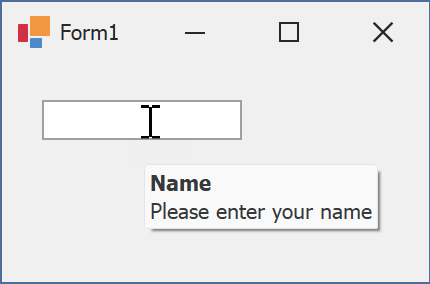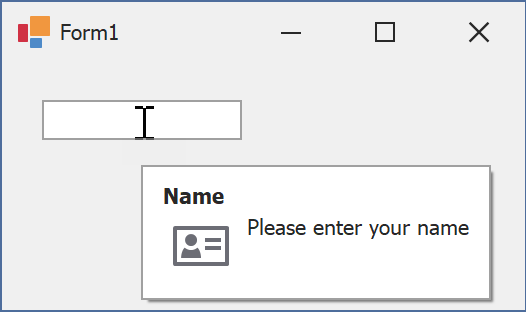ControlNavigator Class
Provides a graphical interface for navigating data-aware controls that implement the INavigatableControl interface (this interface is implemented by all DevExpress data-aware container controls).
Namespace: DevExpress.XtraEditors
Assembly: DevExpress.XtraEditors.v25.2.dll
NuGet Package: DevExpress.Win.Navigation
Declaration
Related API Members
The following members return ControlNavigator objects:
Remarks
The ControlNavigator allows an end-user to manipulate records in an external data-aware control. It is derived from the NavigatorBase class, and so it inherits properties and methods common to all data navigation controls.

The ControlNavigator displays built-in buttons that enable a user to scroll forward or backward through records one at a time, go to the first record, go to the last record, insert a new record, post data changes, cancel data changes and delete a record. You can also add custom buttons, when required. To access built-in and custom buttons, use the DataNavigator.Buttons property. To perform custom actions on button clicks, handle the NavigatorBase.ButtonClick event.
For the ControlNavigator to manipulate records in an external control, this external control must implement the DevExpress.XtraEditors.INavigatableControl interface. This interface is implemented by the GridControl, TreeList and VGridControl classes. Use the ControlNavigator.NavigatableControl property to bind such a control to the ControlNavigator.
The ControlNavigator can display a text string that specifies the current record and the total record count in the bound control. Use the NavigatorBase.TextLocation and NavigatorBase.TextStringFormat to customize the display of this text.
The GridControl supports an embedded data navigator, which can be enabled with the GridControl.UseEmbeddedNavigator property. This embedded navigator’s functionality is equivalent to the functionality of the ControlNavigator. So, you can choose to use either the embedded navigator or an external ControlNavigator.
Tooltips
DevExpress controls support regular and super tooltips. Enable the ShowToolTips option to display tooltips when the mouse pointer hovers over the control.
Customize Regular Tooltip Text
Use the following properties of the target control to specify regular tooltip text and title:
API | Description |
|---|---|
Specifies tooltip text. You can use line breaks in regular tooltips. | |
Specifies whether to parse HTML tags in text. | |
Specifies the tooltip title. If you do not specify tooltip text, the tooltip is not displayed even if you specify the title. |
The following code snippet specifies tooltip text and title for a TextEdit editor:
public Form1() {
InitializeComponent();
textEdit1.ShowToolTips = true;
textEdit1.ToolTipTitle = "Name";
textEdit1.ToolTip = "Please enter your name";
}

Assign an Image to Regular Tooltips
Use the control’s ToolTipIconType property to assign a predefined icon. The ToolTipController.IconSize property specifies icon size.
Assign a custom image as follows:
- Create a ToolTipController and assign it to the control’s ToolTipController property.
- Create an image collection and assign it to the ToolTipController.ImageList property.
- Handle the ToolTipController.BeforeShow event. Use the e.ImageOptions parameter to assign a raster or vector image to the tooltip.
Note
The ToolTipIconType property has priority over e.ImageOptions. If you assign a custom image, set ToolTipIconType to None.
The following code snippet assigns a custom image to the TextEdit tooltip:
Note
textEdit1, toolTipController1, and svgImageCollection1 were created at runtime.
public Form1() {
InitializeComponent();
textEdit1.ShowToolTips = true;
textEdit1.ToolTipTitle = "Name";
textEdit1.ToolTip = "Please enter your name";
textEdit1.ToolTipController = toolTipController1;
toolTipController1.ImageList = svgImageCollection1;
toolTipController1.BeforeShow += ToolTipController1_BeforeShow;
}
private void ToolTipController1_BeforeShow(object sender, ToolTipControllerShowEventArgs e) {
ToolTipController controller = sender as ToolTipController;
if (e.ToolTip == textEdit1.ToolTip)
e.ImageOptions.SvgImage = (controller.ImageList as SvgImageCollection)["personalCard"];
}

Display a Super Tooltip
Use the control’s SuperTip property to assign a super tooltip. If you wish to use HTML tags in a super tooltip, enable the SuperToolTip.AllowHtmlText property.
Setting the ToolTipController.ToolTipType property to SuperTip converts existing regular tooltips to super tooltips.

Tip
Read the following help topic for information on how to customize super tooltips: Hints and Tooltips.